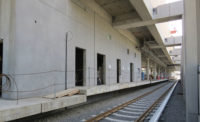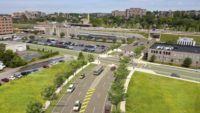A 26-mile-long commuter rail project constructed across multiple suburban Dallas communities seems destined to be a marathon effort. Add in an assortment of daunting challenges presented by the pandemic and the DART Silver Line project feels more like completing an Ironman competition.
From the earliest stages of planning for the $1.9-billion Silver Line project, Dallas Area Rapid Transit knew it faced a long list of stakeholders. The regional rail line, which is currently scheduled for completion in 2025, will extend between DFW Airport and Plano, traversing seven cities: Grapevine, Coppell, Dallas, Carrollton, Addison, Richardson and Plano. The project would also require coordination with five railroad companies. Although it will provide new rail service, the project uses an existing freight rail alignment. Freight service would need to continue on portions of the project during construction. Further, the alignment is used by multiple utilities, including 15 miles of high-pressure natural gas lines and 22 miles of fiber optic lines that are part of a coast-to-coast line.

The 26-mile alignment includes 53 grade crossings, some requiring major new structures and road reconstructions.
Photos courtesy of Dallas Area Rapid Transit
“It’s incredibly challenging when you have so many stakeholders that you’ve got to work with to get design approvals and construction rights of entry and, in some cases, operational agreements,” says Deanna Leggett, DART executive vice president and chief development officer. “Then on top of that, you need to do all of this during a pandemic, right when the contractors want to build, build, build and designs are still being advanced.”
The design-build contractor, Archer Western Herzog—a joint venture between Archer Western Construction and Herzog Contracting Corp.—was given notice to proceed on the project in 2019. At that time, some agreements with stakeholders were still being finalized. Leggett says that while that certainly slowed progress from the start, the pandemic ground the process to a crawl.
“When we got hit by the pandemic in early 2020, it made negotiations more challenging because nobody was meeting at the time,” she says. “You needed things like access to properties to do surveys, and you can’t because nobody wants to interact with other humans. Everything at that time required collaboration with external stakeholders, whether it’s property owners, railroads or some of our partner cities. And nobody was taking meetings, and we were still figuring out how to meet virtually.”

In 2023, crews are expected to make significant progress on constructing the second rail line adjacent to the existing one.
Photos courtesy of Dallas Area Rapid Transit
Understanding Design-Build
Adding to the challenges, many of the stakeholders had no experience working with design-build contracts. Leggett says the procurement method was used successfully on previous DART light rail projects, including the Orange line. However, design-build has been less efficient on the Silver line, given the number and diversity of stakeholders involved.
“Some [stakeholders] are not comfortable with the design-build method,” she says. “When we submit a design package, they want everything perfect because they are used to design-bid-build. They’re hesitant to issue design comments or design approvals without seeing everything neatly tied up in a bow.”
Meanwhile, the AWH team needed to keep the project moving. In addition to its own schedules, AWH had to consider the impact on the numerous subcontractors on the project, including a 30% minimum disadvantaged, minority and/or women-owned business enterprise [DMWBE] requirement, says Matt Hemsath, senior project manager at AWH.
“A lot of those companies don’t have the cash flow and the ability to weather massive delays like some of the larger companies,” he says. “When we tie up 95% of a company’s bonding capacity, we’ve got to try to get them going.”

Since the project was procured in 2018, labor costs on the project are up by 30%.
Photos courtesy of Dallas Area Rapid Transit
Although a linear construction sequence from one end of the alignment to other would have been ideal, the team had to completely resequence the project. “Our goal was to take everything that we could actually move on and get it moving—don’t delay it in any way, shape or form,” says Ruben Landa, public involvement and S/D/M/WBE compliance manager at WSP, which serves with Arredondo, Zepeda & Brunz as DART’s project manager and owner’s representative on the project. “So then once we get certain sections completed, we could really focus on those areas that are lagging and get those sped up to meet the schedule.”
“Our goal was to take everything that we could actually move on and get it moving.”
—Ruben Landa, WSP
For AWH, one element of the job that needed to move forward as soon as possible was utility relocation. “We had to schedule a lot of outages,” Hemsath recalls. “Some of it—like the gas lines—was local distribution, but the fiber optic lines required scheduling what guys from L.A. to D.C. were doing.”
As of December, Hemsath says nearly 90% of utility relocation has been completed. The other early schedule item was building the project’s 10 stations. All of the stations were designed to be structurally identical, including the foundation systems. Hemsath says the area’s geography includes a consistent layer of rock that is about 30 ft below grade. Each station is founded on 36 shafts drilled to the rock layer.
“For the most part, the stations are identical,” he says. “The length of the platforms are the same, the height of the platforms over the rails are the same, the structural steel is the same and the roofs are the same. So we were able to push that forward and get going on those pieces fairly quickly.”

Although all of the 10 stations have identical structural designs, communities were allowed to create a unique look for their respective stations.
Image courtesy of Dallas Area Rapid Transit

Although the structures are the same, DART wanted each station to uniquely represent the communities in which they are located. Landa says DART provided each community a budget to help it customize the look of each station to its liking.
“They had an opportunity to commission an artist to do an art piece like a sculpture or a statue if they wanted to. Or they can use the money to do windscreens and panels or louvers and pavers or different color and lighting. It was really an open canvas for them, but had to fit with their budget.”
Hemsath says he expects stations to be substantially complete by the end of 2023.
Along the alignment, the project team has to contend with 53 grade crossings, including a few significant structures and road reconstructions. One signature structure is a 110-ft-long bridge over Midway Road in Addison. The bridge’s design includes a tubular steel arch that is painted blue to mimic the iconic Arapaho Bridge in Addison. Crews were able to truck in a roughly 50-ft-long section and a 60-ft section to create the connection. During a 48-hour shutdown, crews were able to pick and place the two sections within a ¾-in. tolerance.
Other major crossings include lowering the roadway on Hillcrest Road in Dallas to pass under the at-grade rail line. At Coit Road, also in Dallas, a bridge will carry the roadway over the rail line.

A 100-ft-long tubular steel arch bridge was built over Midway Road in Addison during a 48-hour shutdown.
Photo courtesy of Dallas Area Rapid Transit
Escalation Situation
In addition to the project’s schedule challenges, the team also finds itself working through a tough labor market as well as dealing with cost escalations and supply chain issues. “Escalations have wreaked havoc on the industry, and we’re not immune from that,” Hemsath says. “Since the job was procured in 2018, my labor costs have gone up 30%.... Some of our products have gone up 50%.”
Looking ahead, Hemsath says he expects work will be underway on every section of the alignment by the second quarter of 2023. The next major push will be track work, which is currently only 15% complete. The current alignment has one existing rail line. A second line will be constructed directly adjacent to the existing one. Hemsath says he expects that work to complete in 2023. Once the new line is finished, crews will replace the existing jointed rail with new continuous welded rail on concrete ties. Crews will also install nearly 1 million sq ft of sound walls.
“We’re going into 2023 in a much better place than we were at this time last year,” Leggett says. “We’ve made significant progress, and there are some exciting things that are going to happen in relative short order…. This is a project that DART and the communities have been talking about for a really long time, and it’s important for everyone to see that elements of this project are coming to fruition and we’re delivering on our promises.”



